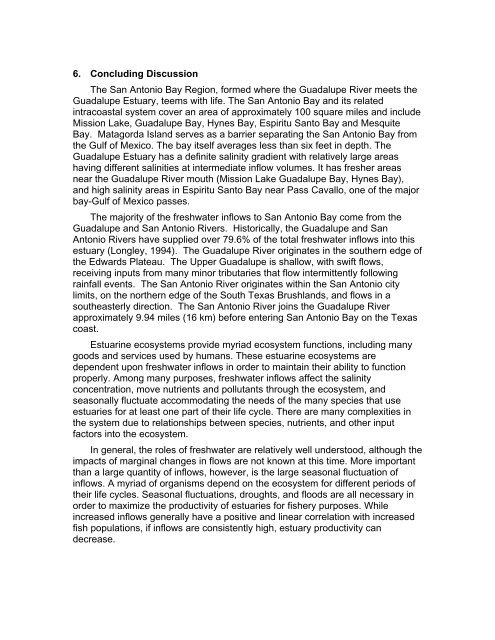The Economic Value of Water and Ecosystem Preservation
The Economic Value of Water and Ecosystem Preservation
The Economic Value of Water and Ecosystem Preservation
You also want an ePaper? Increase the reach of your titles
YUMPU automatically turns print PDFs into web optimized ePapers that Google loves.
6. Concluding Discussion<br />
<strong>The</strong> San Antonio Bay Region, formed where the Guadalupe River meets the<br />
Guadalupe Estuary, teems with life. <strong>The</strong> San Antonio Bay <strong>and</strong> its related<br />
intracoastal system cover an area <strong>of</strong> approximately 100 square miles <strong>and</strong> include<br />
Mission Lake, Guadalupe Bay, Hynes Bay, Espiritu Santo Bay <strong>and</strong> Mesquite<br />
Bay. Matagorda Isl<strong>and</strong> serves as a barrier separating the San Antonio Bay from<br />
the Gulf <strong>of</strong> Mexico. <strong>The</strong> bay itself averages less than six feet in depth. <strong>The</strong><br />
Guadalupe Estuary has a definite salinity gradient with relatively large areas<br />
having different salinities at intermediate inflow volumes. It has fresher areas<br />
near the Guadalupe River mouth (Mission Lake Guadalupe Bay, Hynes Bay),<br />
<strong>and</strong> high salinity areas in Espiritu Santo Bay near Pass Cavallo, one <strong>of</strong> the major<br />
bay-Gulf <strong>of</strong> Mexico passes.<br />
<strong>The</strong> majority <strong>of</strong> the freshwater inflows to San Antonio Bay come from the<br />
Guadalupe <strong>and</strong> San Antonio Rivers. Historically, the Guadalupe <strong>and</strong> San<br />
Antonio Rivers have supplied over 79.6% <strong>of</strong> the total freshwater inflows into this<br />
estuary (Longley, 1994). <strong>The</strong> Guadalupe River originates in the southern edge <strong>of</strong><br />
the Edwards Plateau. <strong>The</strong> Upper Guadalupe is shallow, with swift flows,<br />
receiving inputs from many minor tributaries that flow intermittently following<br />
rainfall events. <strong>The</strong> San Antonio River originates within the San Antonio city<br />
limits, on the northern edge <strong>of</strong> the South Texas Brushl<strong>and</strong>s, <strong>and</strong> flows in a<br />
southeasterly direction. <strong>The</strong> San Antonio River joins the Guadalupe River<br />
approximately 9.94 miles (16 km) before entering San Antonio Bay on the Texas<br />
coast.<br />
Estuarine ecosystems provide myriad ecosystem functions, including many<br />
goods <strong>and</strong> services used by humans. <strong>The</strong>se estuarine ecosystems are<br />
dependent upon freshwater inflows in order to maintain their ability to function<br />
properly. Among many purposes, freshwater inflows affect the salinity<br />
concentration, move nutrients <strong>and</strong> pollutants through the ecosystem, <strong>and</strong><br />
seasonally fluctuate accommodating the needs <strong>of</strong> the many species that use<br />
estuaries for at least one part <strong>of</strong> their life cycle. <strong>The</strong>re are many complexities in<br />
the system due to relationships between species, nutrients, <strong>and</strong> other input<br />
factors into the ecosystem.<br />
In general, the roles <strong>of</strong> freshwater are relatively well understood, although the<br />
impacts <strong>of</strong> marginal changes in flows are not known at this time. More important<br />
than a large quantity <strong>of</strong> inflows, however, is the large seasonal fluctuation <strong>of</strong><br />
inflows. A myriad <strong>of</strong> organisms depend on the ecosystem for different periods <strong>of</strong><br />
their life cycles. Seasonal fluctuations, droughts, <strong>and</strong> floods are all necessary in<br />
order to maximize the productivity <strong>of</strong> estuaries for fishery purposes. While<br />
increased inflows generally have a positive <strong>and</strong> linear correlation with increased<br />
fish populations, if inflows are consistently high, estuary productivity can<br />
decrease.
















